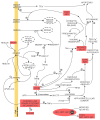Detecting Early Cognitive Decline in Alzheimer's Disease with Brain Synaptic Structural and Functional Evaluation
- PMID: 36830892
- PMCID: PMC9952956
- DOI: 10.3390/biomedicines11020355
Detecting Early Cognitive Decline in Alzheimer's Disease with Brain Synaptic Structural and Functional Evaluation
Abstract
Early cognitive decline in patients with Alzheimer's (AD) is associated with quantifiable structural and functional connectivity changes in the brain. AD dysregulation of Aβ and tau metabolism progressively disrupt normal synaptic function, leading to loss of synapses, decreased hippocampal synaptic density and early hippocampal atrophy. Advances in brain imaging techniques in living patients have enabled the transition from clinical signs and symptoms-based AD diagnosis to biomarkers-based diagnosis, with functional brain imaging techniques, quantitative EEG, and body fluids sampling. The hippocampus has a central role in semantic and episodic memory processing. This cognitive function is critically dependent on normal intrahippocampal connections and normal hippocampal functional connectivity with many cortical regions, including the perirhinal and the entorhinal cortex, parahippocampal cortex, association regions in the temporal and parietal lobes, and prefrontal cortex. Therefore, decreased hippocampal synaptic density is reflected in the altered functional connectivity of intrinsic brain networks (aka large-scale networks), including the parietal memory, default mode, and salience networks. This narrative review discusses recent critical issues related to detecting AD-associated early cognitive decline with brain synaptic structural and functional markers in high-risk or neuropsychologically diagnosed patients with subjective cognitive impairment or mild cognitive impairment.
Keywords: ATN biomarkers; Alzheimer’s disease; cognitive decline; functional connectivity; hippocampus; large-scale networks; memory; structural connectivity; synaptic density; synaptic function.
Conflict of interest statement
The author declares no conflict of interest.
Figures





Similar articles
-
Network Disruption and Cerebrospinal Fluid Amyloid-Beta and Phospho-Tau Levels in Mild Cognitive Impairment.J Neurosci. 2015 Jul 15;35(28):10325-30. doi: 10.1523/JNEUROSCI.0704-15.2015. J Neurosci. 2015. PMID: 26180207 Free PMC article.
-
Medial temporal lobe connectivity and its associations with cognition in early Alzheimer's disease.Brain. 2020 Apr 1;143(4):1233-1248. doi: 10.1093/brain/awaa068. Brain. 2020. PMID: 32252068 Free PMC article.
-
Disrupted functional connectivity between perirhinal and parahippocampal cortices with hippocampal subfields in patients with mild cognitive impairment and Alzheimer's disease.Oncotarget. 2017 May 16;8(58):99112-99124. doi: 10.18632/oncotarget.17944. eCollection 2017 Nov 17. Oncotarget. 2017. PMID: 29228757 Free PMC article.
-
Core candidate neurochemical and imaging biomarkers of Alzheimer's disease.Alzheimers Dement. 2008 Jan;4(1):38-48. doi: 10.1016/j.jalz.2007.08.006. Epub 2007 Dec 21. Alzheimers Dement. 2008. PMID: 18631949 Review.
-
Understanding disease progression and improving Alzheimer's disease clinical trials: Recent highlights from the Alzheimer's Disease Neuroimaging Initiative.Alzheimers Dement. 2019 Jan;15(1):106-152. doi: 10.1016/j.jalz.2018.08.005. Epub 2018 Oct 13. Alzheimers Dement. 2019. PMID: 30321505 Review.
Cited by
-
EEG-based graph network analysis in relation to regional tau in asymptomatic Alzheimer's disease.Brain Commun. 2025 Apr 15;7(2):fcaf138. doi: 10.1093/braincomms/fcaf138. eCollection 2025. Brain Commun. 2025. PMID: 40255689 Free PMC article.
-
Growth associated protein 43 (GAP-43) predicts brain amyloidosis in Alzheimer's dementia continuum: an [18 F] AV-45 study.BMC Neurol. 2025 Apr 1;25(1):134. doi: 10.1186/s12883-025-04140-5. BMC Neurol. 2025. PMID: 40170060 Free PMC article.
-
Taurine reduces microglia activation in the brain of aged senescence-accelerated mice by increasing the level of TREM2.Sci Rep. 2024 Mar 28;14(1):7427. doi: 10.1038/s41598-024-57973-4. Sci Rep. 2024. PMID: 38548872 Free PMC article.
-
From Plaques to Pathways in Alzheimer's Disease: The Mitochondrial-Neurovascular-Metabolic Hypothesis.Int J Mol Sci. 2024 Oct 31;25(21):11720. doi: 10.3390/ijms252111720. Int J Mol Sci. 2024. PMID: 39519272 Free PMC article. Review.
-
A systematic review of the neuropathology and memory decline induced by monosodium glutamate in the Alzheimer's disease-like animal model.Front Pharmacol. 2023 Oct 24;14:1283440. doi: 10.3389/fphar.2023.1283440. eCollection 2023. Front Pharmacol. 2023. PMID: 37942488 Free PMC article.
References
-
- Garcia-Morales V., Gonzalez-Acedo A., Melguizo-Rodriguez L., Pardo-Moreno T., Costela-Ruiz V.J., Montiel-Troya M., Ramos-Rodriguez J.J. Current understanding of the physiopathology, diagnosis and therapeutic approach to Alzheimer’s disease. Biomedicines. 2021;9:1910. doi: 10.3390/biomedicines9121910. - DOI - PMC - PubMed
Publication types
LinkOut - more resources
Full Text Sources

